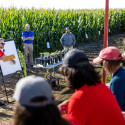Five UW faculty inducted into national academies
Five University of Wisconsin–Madison faculty have been recognized for their research accomplishments through recent induction into the National Academies.
Election to the National Academies – comprised of the National Academy of Sciences (NAS), the National Academy of Engineering (NAE), the Institute of Medicine (IOM), and the National Research Council (NRC) – is considered one of the highest honors accorded to an American scientist, engineer or scholar. NAS and NAE honor “outstanding contributions” to research, practice or education. The IOM chooses members for their contributions to health and medicine.
UW–Madison faculty recognized in 2006 include:
Richard M. Amasino, a professor of biochemistry. Elected to NAS, Amasino’s lab focuses on studies of how plants respond to seasonal cues to prompt flowering. His discoveries include finding genes that regulate when a plant flowers and those that govern the plant’s internal clock.
Mary Anderson, a professor of geology and geophysics, was one of 76 individuals nationwide inducted into the National Academy of Engineering. A hydrogeologist, Anderson studies the movement of groundwater, the water that flows beneath the earth’s surface and serves as a source for well and spring water. In particular, Anderson is recognized for her expertise in the design and application of “groundwater models,” mathematical simulations that help predict how groundwater is moving underground.
R. Alta Charo, UW–Madison professor of law and bioethics, was admitted to the National Academies’ Institute of Medicine in October. She is a leading scholar of bioethics, public policy on biotechnology, stem cells, cloning and reproductive technologies and health. Charo participates in various bioethics studies and commissions nationally, including an appointment to the President’s National Bioethics Advisory Commission from 1996 to 2001.
Barry Ganetzky, a professor of genetics and the Steenbock Professor of Biological Sciences, was inducted into the NAS. Ganetzky is widely known for his application of genetics to studies of how cells generate and propagate electrical impulses in the nervous system. His work has contributed to the understanding of human neurological disorders, drug discovery and insecticide development.
John Kutzbach, professor emeritus of atmospheric and oceanic sciences and the former director of the Nelson Institute for Environmental Studies’ Center for Climatic Research, was elected to membership in NAS. Kutzbach uses powerful computer models to study past and future climate. His work has been instrumental to validating the computer models scientists use to predict future climate change.
# # #




